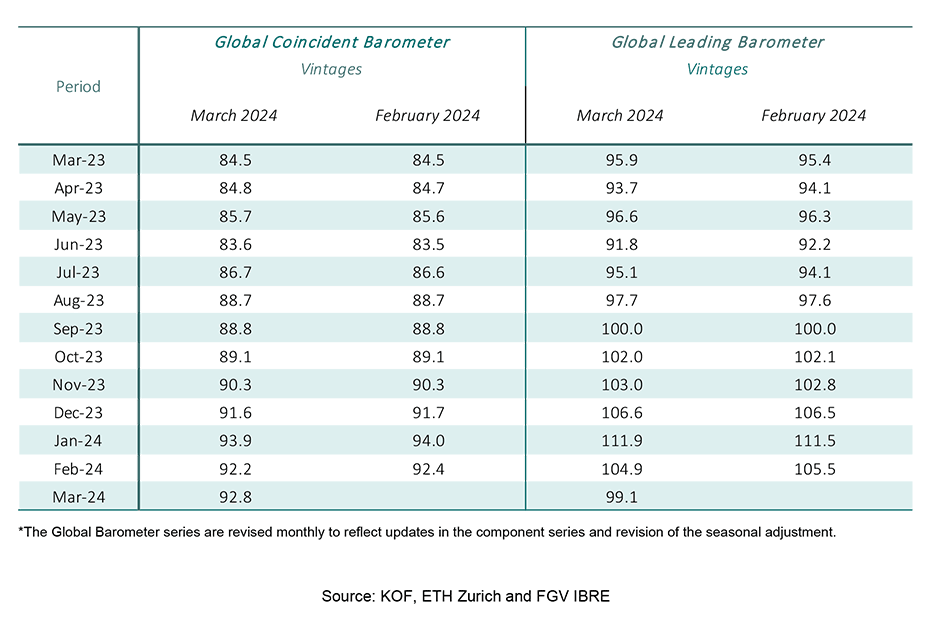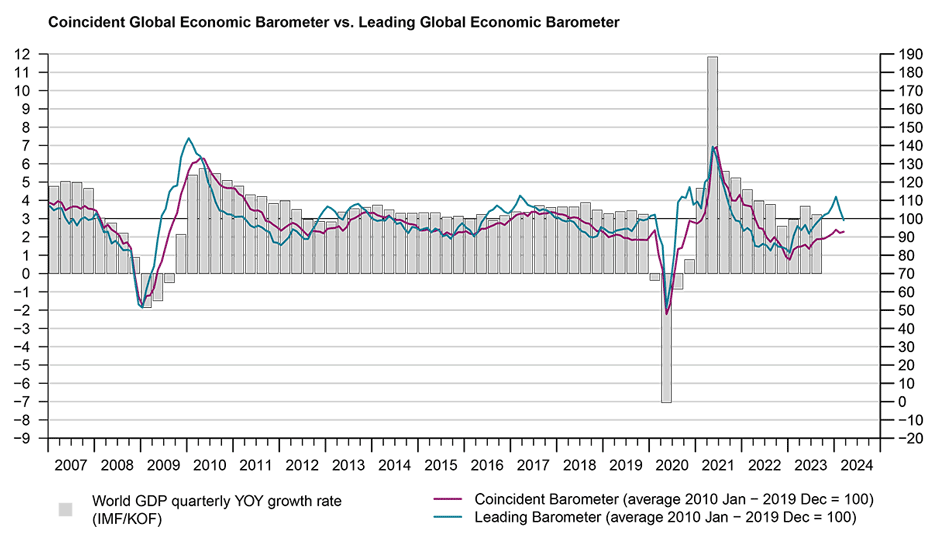Leading Global Barometer signals slower recovery in coming months
In March 2024, the Leading Global Barometer records a setback, and the Coincident Barometer rises slightly after a fall in the previous month. The results reflect a sluggish development of global economic activity in the first quarter of 2024 and suggest that this will only improve slowly in the coming months.

The Coincident Global Economic Barometer increases 0.6 points, whereas the Leading Barometer decreases 5.8 points in March, reaching 92.8 points and 99.1 points, respectively. The modest rise in the Coincident Barometer was determined by the Western Hemisphere and Europe, while the significant drop in the Leading barometer is driven almost entirely by the Asia, Pacific & Africa region. Both indicators record levels below 100 points and thus below the medium-term average. However, the leading indicator continues to be higher than the coincident indicator.
“Although recent data still points to an improving global economy, albeit from below average levels, the Leading Global Indicator in particular suggests that the recovery is slowing its pace. While this is true for most regions and sectors, the decline in the Leading Indicator is mainly due to data from Asia. The high level of uncertainty surrounding the Chinese economy is likely to be a key factor”, evaluates Jan-Egbert Sturm, Director of KOF Swiss Economic Institute.

“The Leading Indicator suggests that the gobal recocery might slow down. The high level of uncertainty surrounding the Chinese economy is likely to be a key factor.”Jan-Egbert Sturm, Director of KOF Swiss Economic Institute
Coincident Barometer – regions and sectors
The slight increase in the Coincident Barometer in March is driven by contributions of the Western Hemisphere and Europe of 0.4 and 0.6 points, respectively, while the indicator value for the Asia, Pacific & Africa region remains constant. Since January 2024, the regional indicators for Europe and the Asia, Pacific & Africa region have remained relatively stable, indicating a slowdown in the rate of improvement seen in 2023. In contrast, the Western Hemisphere maintains an upward tendency and records the highest level among the regions. The regional coincident indicators continue to fluctuate in the 90-point band, signalling a continued modest recovery in global economic activity.
The development of the Coincident sector indicators in March is varied, with increases in Industry, Construction and Economy (aggregated business and consumer evaluations) and decreases in Trade and Services. With these results, Industry returns to having the highest level among the sectors.
Leading Barometer – regions and sectors
The Leading Global Barometer leads the world economic growth rate cycle by three to six months on average. In March, the largest negative contribution comes from the Asia, Pacific & Africa region, with -5.0 points. The Western Hemisphere and Europe contribute with -0.5 and -0.3 points, respectively, to the development of the final indicator. The indicator for the Asia, Pacific & Africa region reflects a tempering of the optimism of previous months, and the region’s indicator has now returned to a level below 100 points, which had not happened since July of 2023. Expectations for the global economic cycle, coming from Europe and the Western hemisphere, have also been dampened.
In March, all the Leading sector indicators decrease for the second consecutive month, with Economy (aggregated business and consumer evaluations) remaining as the only sector to register a level below 100 points.

The Global Economic Barometers
The Global Economic Barometers are a system of indicators enabling timely analysis of global economic development. They represent a collaboration between the KOF Swiss Economic Institute of the ETH Zurich in Switzerland and Fundação Getulio Vargas (FGV), based in Rio de Janeiro, Brazil. The system consists of two composite indicators, the Coincident Barometer and the Leading Barometer. The Coincident Barometer reflects the current state of economic activity, while the Leading Barometer provides a cyclical signal roughly six months ahead of current economic developments.
The two Barometers comprise the results of economic tendency surveys conducted in more than 50 countries with the aim of achieving the broadest possible global coverage. The advantages of economic tendency surveys are that their results are usually readily available and are not substantially revised after first publication.
The Coincident Barometer includes more than 1,000 different time series, while the Leading Barometer consists of over 600 time series. Cross-correlation analysis is used to decide which individual time series are included in the barometers. This involves correlating the individual time series with a reference series. The reference series used is the year-on-year growth rate of global gross domestic product (GDP), where the individual national GDPs are aggregated at purchasing power parity to form global GDP. A time series is only included in a Barometer if it shows a sufficiently high correlation and a suitable synchronization or lead with the reference series. The time period used for this correlation analysis currently runs from January 2010 to December 2019.
The series of the two Barometers are revised each month at publication and are standardized to have a mean of 100 and a standard deviation of 10 for the 10-year period previous to the most recent observations.
The methodology is described in:
Klaus Abberger, Michael Graff, Aloisio Jr. Campelo, Anna Carolina Lemos Gouveia, Oliver Müller and Jan-Egbert Sturm (2020), The Global Economic Barometers: Composite indicators for the world economy. KOF Working Papers, vol. 471, Zurich: KOF Swiss Economic Institute, ETH Zurich, 2020.
Contact
KOF Konjunkturforschungsstelle
Leonhardstrasse 21
8092
Zürich
Switzerland
